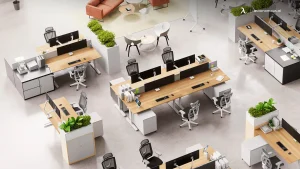Smart Furniture – Technology Meets Design

These furniture pieces compensate for its technological imperfections by integrating functionality within the artefact, tailored to home spaces, thereby fashioning objects that help reconfigure its arrangement without the appearance of a tech invasion.
Smart furniture markets are just start to open up. Which shows that B2B players who use the best technologies, put the user experience first and remain flexible, can do business in this new and rapidly changing environment.
Connectivity
It has become very fashionable for growing businesses to outfit otherwise ordinary furniture pieces with IoT sensors, voice-activated controls, even wireless charging – turning ordinary furniture into high-tech items that people will want.
It could be sensory-enabled to access gestures and voice recognition, giving users the most experience as it is embedded in the design. It can be developed using off-the-shelf communication protocols available to developers – Bluetooth, Zigbee, Wi-Fi and others.
The main selling point for smart furniture is the way that it operates as an input for tracking your habits, and an output for giving suggestions for your usage. For instance, you could sit in a smart chair that tracks your movements and is able to give you tips for your posture and wellness (for example, ‘try sitting like this for a minute’); another example would be a piece of smart furniture that tracks your energy use and sends you suggestions to reduce your energy bill.
Intelligence
Smart furniture with advanced sensors that are able to react to interactions and provide an enhanced usability is quite possible: a smart bed (to keep track of your sleeping habits), a desk (assisted by posture sensors to help you sit comfortably) or a cabinet (capable of showing an inventory) can all help lead to a more efficient and comfortable way of life.
Features like wireless charging, fingerprint unlocking, LED lights, and built-in Bluetooth speakers are turning conventional home furniture into the internet of things in the house, adding value to the home as well as boosting the sales potential of smart furniture brands.
Companies that sit on their laurels or hedge their bets on the changing smart furniture sea won’t survive the breakers of rapid innovation. Companies hoping to retain a leadership role must build cross-disciplinary talent, prioritise user experience, remain fluid, invest in addressing the security challenges, and prepare for a battle in which they will need to educate and communicate with their customers. Companies using these tactics can board the smart furniture-waves of innovation with confidence, knowing that the sailors in their leadership positions will always land their commerce with the shore – housing the end-user – exactly where they want it to land. This article is a slightly modified extended version of a High Powered Brief . High Powered Briefs (HPPs) are modern versions of the venerable humanities survey course. They apply research-based frameworks to specific domains and then distil the findings into concise, entertaining, and above all, practical prose. These 2,000-word bursts of knowledge help entrepreneurs, managers and decision-makers reach the bottom line. The Brief Network delivers academically sound briefs to a business audience with the refined prose of the popular press. It is the go-to place for short-form content that is efficiently created and disseminated.
Personalization
Tailored to users and engineered around IoT technology, furniture is creating more adaptable home and office environments, including sofas that hug you more or less closely depending on your mood, and coffee tables equipped with power-transmitting surfaces so devices never need cables. High-tech furniture hasn’t forgotten how to be cool.
As health and wellbeing shift to the centre of life, the focus of smart furniture pieces is on well-being features, thanks to which these products bring experiences at the most optimal moment of time, for instance by a massage chair or a mattress that tracks sleep cycles.
For instance, leveraging real-time personalisation, furniture retailers can provide recommendations to consumers looking to purchase smart furniture for their homes, by personalising content and recommendations accordingly based on their individual data and preferences, with the help of technologies such as AR, VR and AI; forecasting an upcoming trend wherein technologies such as AR/VR/AI will personalise customer journeys for furniture retail.This significantly expedites the purchase of products, while at the same time enhancing consumer experience.
Convenience
they provide for the modern user all sorts of accessories which can contribute to people’s comfort while seated. For example, modern furniture has USB-ports and speakers or touchscreens to get connected; built-in storage solutions to keep everything in order; and even air purifiers to ensure the necessary amount of clean air without any dust or germs.
An intelligent bed monitors your sleeping patterns and heart rate to record an accurate index of healthy sleep, while the intelligent chair offers feedback on your posture to straighten you up when you slouch.
Smart pieces of furniture are also developed as new furnishing solutions for miniaturised spaces, designed to fulfil new social functions without betraying aesthetic principles. Take, for instance, a coffee table featuring wireless charging spots so as not to clutter the surface of the table with cords, chargers, and power adapters; or a stylish lamp also capable of functioning as a wireless extender for your Wi-Fi network so that you can access up to 40 smart devices with only one app.

